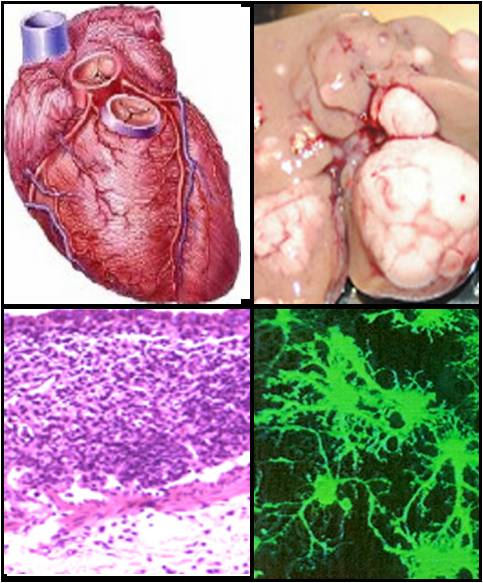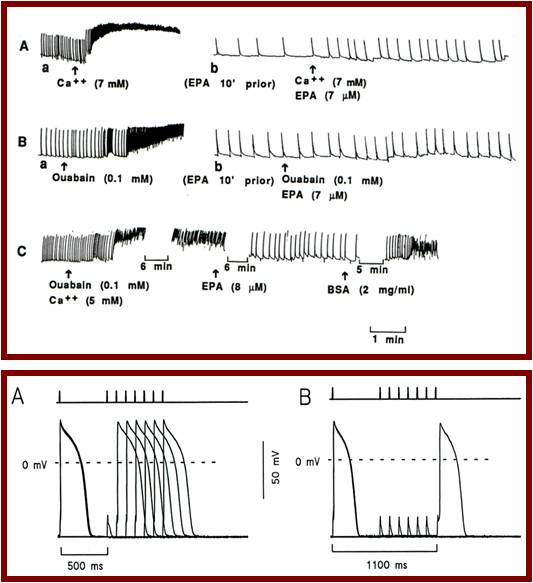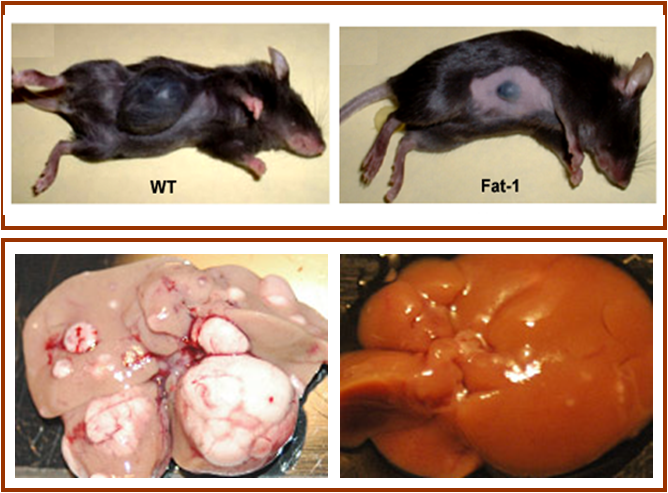 |
Essential to life, lipids come in a wide variety and have many functions in cells besides simply being used for energy. Not only do they make up cell membranes, but they and their products serve as intra- and extra-cellular messengers - controlling and regulating many important bodily functions. Imbalances of lipids cause or play a role in diseases that affect millions worldwide, such as heart disease, cancer, diabetes, Alzheimer's, etc. Certain polyunsaturated fatty acids are especially important components of human nutrition, as adequate levels optimize health and prevent disease. Over the last 15 years, our research has discovered a very important role for omega-3 fatty acids, a class of essential polyunsaturated fatty acids found mainly in fish and fish oils, in disease prevention and health promotion. Still, there is a great deal more we need to learn about these fatty acids in order to optimally apply our knowledge to improving human health. |
|
|
more information
|
||

We investigate the cardioprotective effect of omega-3 fatty acids. An area of special interest to us is the effect of these lipids on cardiac arrhythmia, the main cause of sudden cardiac death. Back in 1994, we initiated a research program to examine the anti-arrhythmic properties of polyunsaturated fatty acids at different levels ranging from molecular biology to clinical trial, using a variety of techniques. We first utilized spontaneously beating neonatal rat cardiac myocytes and a contractility-monitoring system to systematically characterize the effect of various fatty acids on the contraction of isolated heart cells. This demonstrated that free omega-3 fatty acids can rapidly reduce beating rate and are capable of preventing as well as terminating arrhythmias induced by various arrhythmogenic agents. We then used electrophysiological techniques to discover that these fatty acids could reduce the membrane electrical excitability and ion channel activity of cardiac myocytes. Using methods of biochemistry and molecular biology, we were further able to demonstrate the potential interaction of omega-3 fatty acids with ion channel proteins and the effect on gene expression. We next validated the preventive effect of omega-3 preparations on myocardial infarction-induced ventricular fibrillation and cardiac sudden death in a dog model. Finally, we conducted a randomized, double-blinded, placebo-controlled clinical trial to show that the omega-3 fatty acids in fish oils can reduce fatal ventricular arrhythmias in patients at high risk with implanted cardioverter defibrillators (ICDs). Our work has generated a comprehensive set of evidence for the anti-arrhythmic effect of omega-3 fatty acids and demonstrated that the protective action results mainly from the modulation of ion channels and stabilization of the electrical activity of heart cells. Our current and future efforts are focused on identifying the factors/pathways that mediate the protective effects of omega-3 fatty acids and elucidating the molecular mechanism of their action. Selected Publications:
|
||

Whether omega-3 fatty acids have an anti-cancer effect and if tissue ratio of omega-6 to omega-3 fatty acids affects cancer development remain an important topic of cancer research. A challenge in dietary supplementation research is the presence of confounding factors of experimental diets, which often lead to inconsistent or conflicting results. Thus, studies using innovative well-controlled experimental systems/models are needed to address the fatty acids-cancer relationship. The availability of fat-1 transgenic cells and mouse model (capable of converting omega-6 to omega-3 fatty acids and having a higher level of omega-3 and a balanced n-6/n-3 ratio), which were generated by our lab, provides an opportunity to address the issues. Using the fat-1 transgenic cell lines and mice, we have been able to demonstrate that a higher cellular or tissue level of omega-3 fatty acids and a balanced n-6/n-3 fatty acid ratio can suppress cancer cell proliferation or promote apoptotic cell death, reduce tumor formation and growth rate and inhibit cancer cell metastasis in several different kinds of cancer, including breast cancer, lung cancer, melanoma, colon cancer, prostate cancer and hepatocellular carcinoma. Genetic and lipidomic analyses have shown that modification of omega-6 and omega-3 fatty acid concentrations leads to changes in the production of lipid mediators (e.g. PGE2, PGE3) and the expression of cancer related genes (e.g. PTEN, NF-kB, etc.). Our studies have unveiled a lipid regulatory axis (n-6/n-3 fatty acids-lipid mediators-cancer genes) in cancer biology. The results of our studies provide new evidence for the differential effects of omega-6 and omega-3 fatty acids on cancer development and a role for tissue ratio of omega-6 to omega-3 fatty acids in cancer biology. Using the fat-1 mouse model in combination with methods of lipidomics and proteomics, we arm to elucidate the interactions between the lipid molecules (the fatty acids and their metabolites) and cancer-related genes, identify new anti-caner targets and develop lipid formulations for cancer prevention and control. We are also extending these studies to humans. Selected Publications:
|
||
Many human diseases have been linked to inflammation, which is mediated by a number of chemical molecules including lipid mediators and cytokines. Polyunsaturated fatty acids (omega-6 and omega-3 fatty acids) are the precursors of the lipid mediators and might play a role in the initiation and resolution of inflammation. To understand the role played by the tissue status of omega-3 fatty acids in the development of inflammatory diseases, we are utilizing the fat-1 transgenic mouse model, which allows studies to be performed under a well-controlled condition, to look at the local inflammatory responses, the formation of inflammatory lipid mediators (particularly the newly discovered resolvins and protectins) and the expression of inflammatory genes in various models of inflammatory diseases including colitis, hepatitis, pancreatitis, asthma, acute lung injury and retinopathy. Our studies, for the first time under an experimental condition free of confounding factors of diet, have demonstrated a role played by an increased tissue status of omega-3 fatty acids with a decreased omega-6/omega-3 fatty acid ratio in protection against inflammation through suppressing the expression of pro-inflammatory genes (mainly NFkB, TNFa, IL-6 and IL-1b) mediated, in part, by anti-inflammatory lipid mediators (e.g. resolvins and protectins) of long chain omega-3 fatty acids. Our ongoing projects continue to elucidate the molecular pathways of the anti-inflammatory effect by using animal models together with state-of-the-art technologies (e.g. methods of lipidomics, genetics and proteomics). Further understanding of the anti-inflammatory properties of the small molecules derived from omega-3 fatty acids and their regulatory signaling pathways provides new insights into the molecular pathophysiology of chronic diseases and opportunities for the design of therapeutic strategies. Selected Publications:
|
||
Omega-3 long chain polyunsaturated fatty acids, especially docohexaenoic acid (DHA), are highly rich in the nerve system--- about 20-30% of the fatty acids in the brain and retina is the omega-3 fatty acid DHA. As a major building block of the brain, DHA can affect many aspects of neural function, including neurotransmission, membrane fluidity, ion channel and enzyme activity as well as gene expression. In this context, it is of interest and importance to know whether alteration in brain DHA content modifies risk of neurological diseases. We are particularly interested in the potential impact of brain DHA on neuro-inflammation, neuronal apoptosis and neuroregeneration. Using the transgenic fat-1 mice, rich in endogenous DHA, we have discovered that DHA can promote the neurogenesis and neuritogenesis and improve the learning and memory performance in mice; We have also observed that increased tissue levels of DHA in transgenic fat-1 mice favor the regeneration of myelin following nerve injury. In addition, the fat-1 mice (with higher levels of DHA compared with wild-type littermates) were found to be less susceptible to pentylenetetrazol-induced seizures and oxygen-induced retinopathy. These findings motivate us to further investigate the neuroprotective effect of DHA, understand its action network in the brain and explore the potential utility of omega-3 formulations in the treatment of traumatic brain injury and neurodegenerative diseases. Selected Publications:
|
||
|
|
|
|


